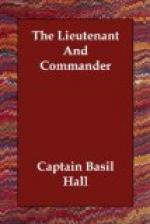“Now, I tell you what it is, my lads, unless you are off the yards, and the sails are hoisted again before any other ship in the squadron, by the Lord Harry I’ll paint your figure-head black!” From that time forward, she beat every ship in the fleet.
As soon as a sufficient number of hands are collected on board the ship which is fitting out, all the spars, except the spare ones, may be got off to the hulk. These consist of topsail yards, topmasts, and top-gallant masts and yards, jib and spanker boom, studding-sail booms, and one or two others. The lower and topsail yards can be fitted on the hulk’s decks, ready to be swayed into their places when the masts are in a state to receive them. If a dockyard lump, or lighter, can be got to put all the spars in, together with the tops and other things which are usually made into a raft and floated off, it may save a great deal of trouble; as it frequently happens that they cannot all be got in before night, and if bad weather comes on, they may break adrift and be lost.
There seems no fixed rule for rigging a ship progressively. Different officers adopt different ways of setting about the operation, and slight variations occur in the arrangement of the ropes; but, generally speaking, everything is disposed according to the long-established rules of seamanship. The grand object is to support each mast laterally by a number of shrouds on each side, inclining slightly abaft the perpendicular, to prevent its falling either sideways or forwards, and also, by means of two stays, the principal stay and the spring stay, both stretching in the line of the keel, to hold it forwards. The width of the ship affords what is called a spread for the rigging, which spread is augmented by the application of broad shelves, called channels, carrying the rigging three or four feet further out on each side, and making its angle with the masts greater, and consequently increasing the support of the shrouds. These channels act merely as out-riggers, for the ultimate point of fixture, or that against which the shrouds pull, is lower down, where long links of iron called chain-plates, are securely bolted through and through the solid ribs of the ship, and rivetted within. The upper ends of these chain-plates are furnished with what are called dead-eyes, great round blocks of wood pierced with holes, through which the lanyards are rove by which the rigging is set up, or drawn almost as tight as bars of iron. The topmasts, rising immediately above the lower masts, are supported chiefly by rigging spread out by the tops, or what people on shore miscall round-tops. These, like the channels for the lower rigging, are mere projections or out-riggers; the true point of support for the topmast rigging is the lower shrouds, the connection being made by what are called futtock shrouds and catharpins. The top-gallant masts, at the next stage aloft, are supported by shrouds passing through the ends of small spars called cross-trees, at the head of the topmast; and so on in succession, up to the sky-scrapers and moon-rakers in some very fly-away ships.




